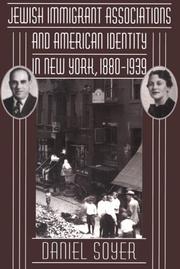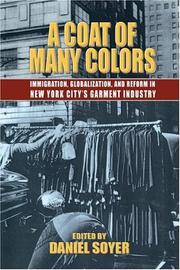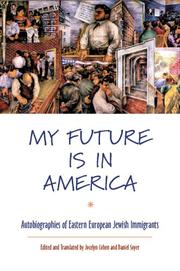| Listing 1 - 10 of 19 | << page >> |
Sort by
|
Book
ISBN: 0814344518 081434450X Year: 2018 Publisher: Wayne State University Press
Abstract | Keywords | Export | Availability | Bookmark
 Loading...
Loading...Choose an application
- Reference Manager
- EndNote
- RefWorks (Direct export to RefWorks)
Landsmanshaftn, associations of immigrants from the same hometown, became the most popular form of organization among Eastern European Jewish immigrants to the United States in the late 19th and early 20th centuries. Jewish Immigrant Associations and American Identity in New York, 1880-1939, by Daniel Soyer, holds an in-depth discussion on the importance of these hometown societies that provided members with valuable material benefits and served as arenas for formal and informal social interaction. In addition to discussing both continuity and transformation as features of the immigrant experience, this approach recognizes that ethnic identity is a socially constructed and malleable phenomenon. Soyer explores this process of construction by raising more specific questions about what immigrants themselves have meant by Americanization and how their hometown associations played an important part in the process.
Immigrants --- Jews --- Jews, East European --- Societies, etc. --- History. --- New York (N.Y.) --- Ethnic relations. --- East European Jews --- Emigrants --- Foreign-born population --- Foreign population --- Foreigners --- Migrants --- Persons --- Aliens --- Hebrews --- Israelites --- Jewish people --- Jewry --- Judaic people --- Judaists --- Ethnology --- Religious adherents --- Semites --- Judaism --- Social groups: religious groups & communities

ISBN: 9780674444171 0674444175 Year: 1997 Publisher: Cambridge ; Massachusetts : Harvard University Press,
Abstract | Keywords | Export | Availability | Bookmark
 Loading...
Loading...Choose an application
- Reference Manager
- EndNote
- RefWorks (Direct export to RefWorks)
Ethnic relations --- Immigrants --- Jews, East European --- Jews --- Societies, etc. --- History. --- New York (State) --- New York (N.Y.) --- Ethnic relations. --- Relations interethniques
Book
ISBN: 1644694913 1644694905 9781644694909 9781644694916 9781644694886 9781644694893 1644694883 1644694891 Year: 2021 Publisher: Brookline, MA : Academic Studies Press,
Abstract | Keywords | Export | Availability | Bookmark
 Loading...
Loading...Choose an application
- Reference Manager
- EndNote
- RefWorks (Direct export to RefWorks)
The Jewish Metropolis: New York from the 17th to the 21st Century covers the entire sweep of the history of the largest Jewish community of all time. It provides an introduction to many facets of that history, including the ways in which waves of immigration shaped New York’s Jewish community; Jewish cultural production in English, Yiddish, Ladino, and German; New York’s contribution to the development of American Judaism; Jewish interaction with other ethnic and religious groups; and Jewish participation in the politics and culture of the city as a whole. Each chapter is written by an expert in the field, and includes a bibliography for further reading. The Jewish Metropolis captures the diversity of the Jewish experience in New York.
Jews --- New York (State) --- History. --- Social life and customs. --- Ethnic relations. --- New York (N.Y.) --- American history. --- Ethnicity. --- Immigration. --- Intergroup relations. --- Jewish Americans. --- Jewish History. --- Jewish community. --- Jewish culture. --- Jews. --- Judaism. --- New York History. --- New York. --- Religion. --- Urban History. --- Yiddish.
Book
ISBN: 1501759892 9781501759888 1501759884 9781501759895 9781501759871 Year: 2022 Publisher: Ithaca : Cornell University Press,
Abstract | Keywords | Export | Availability | Bookmark
 Loading...
Loading...Choose an application
- Reference Manager
- EndNote
- RefWorks (Direct export to RefWorks)
Daniel Soyer's history of the Liberal Party of New York State, 'Left in the Center', shows the surprising relationship between Democratic Socialism and mainstream American politics. Beginning in 1944 and lasting until 2002, the Liberal Party offered voters an ideological seal of approval and played the role of strategic kingmaker in the electoral politics of New York State. The party helped elect presidents, governors, senators, and mayors, and its platform reflected its founders' social democratic principles. In practical politics, the Liberal Party's power resided in its capacity to steer votes to preferred Democrats or Republicans with a reasonable chance of victory. This uneasy balance between principle and pragmatism, which ultimately proved impossible to maintain, is at the heart of the dramatic political story presented in 'Left in the Center'.
Liberalism --- History --- Liberal Party of New York State --- History. --- New York (State) --- Politics and government
Book
ISBN: 9781644694909 Year: 2021 Publisher: Boston, MA
Abstract | Keywords | Export | Availability | Bookmark
 Loading...
Loading...Choose an application
- Reference Manager
- EndNote
- RefWorks (Direct export to RefWorks)

ISBN: 0823224872 0823290735 Year: 2004 Publisher: Fordham University Press
Abstract | Keywords | Export | Availability | Bookmark
 Loading...
Loading...Choose an application
- Reference Manager
- EndNote
- RefWorks (Direct export to RefWorks)
Book
ISBN: 081473832X 9780814738320 9780814767702 0814767702 147981105X 9781479811052 Year: 2013 Publisher: New York, NY : New York University Press,
Abstract | Keywords | Export | Availability | Bookmark
 Loading...
Loading...Choose an application
- Reference Manager
- EndNote
- RefWorks (Direct export to RefWorks)
Describes New York’s transformation into a Jewish city Emerging Metropolis tells the story of New York’s emergence as the greatest Jewish city of all time. It explores the Central European and East European Jews’ encounter with New York City, tracing immigrants’ economic, social, religious, political, and cultural adaptation between 1840 and 1920. This meticulously researched volume shows how Jews wove their ambitions and aspirations—for freedom, security, and material prosperity—into the very fabric and physical landscape of the city.
Jews --- Hebrews --- Israelites --- Jewish people --- Jewry --- Judaic people --- Judaists --- Ethnology --- Religious adherents --- Semites --- Judaism --- History --- New York (N.Y.) --- New York (City) --- Ni︠u︡ Ĭork (N.Y.) --- Novi Jork (N.Y.) --- Nova Iorque (N.Y.) --- Nyu-Yorḳ (N.Y.) --- Nueva York (N.Y.) --- Nu Yorḳ (N.Y.) --- Nyuyok (N.Y.) --- Nuyorḳ (N.Y.) --- New York City (N.Y.) --- Niyū Yūrk (N.Y.) --- Niyūyūrk (N.Y.) --- Niu-yüeh (N.Y.) --- Nowy Jork (N.Y.) --- City of New York (N.Y.) --- New York Stad (N.Y.) --- نيويورك (N.Y.) --- Táva Nueva York (N.Y.) --- Nyu-York Şähäri (N.Y.) --- Нью-Йорк (N.Y.) --- Горад Нью-Ёрк (N.Y.) --- Horad Nʹi︠u︡-I︠O︡rk (N.Y.) --- Нью-Ёрк (N.Y.) --- Ню Йорк (N.Y.) --- Nova York (N.Y.) --- Çĕнĕ Йорк (N.Y.) --- Śĕnĕ Ĭork (N.Y.) --- Dakbayan sa New York (N.Y.) --- Dinas Efrog Newydd (N.Y.) --- Efrog Newydd (N.Y.) --- Nei Yarrick Schtadt (N.Y.) --- Nei Yarrick (N.Y.) --- Νέα Υόρκη (N.Y.) --- Nea Yorkē (N.Y.) --- Ciudad de Nueva York (N.Y.) --- Novjorko (N.Y.) --- Nouvelle York (N.Y.) --- Nua-Eabhrac (N.Y.) --- Cathair Nua-Eabhrac (N.Y.) --- Caayr York Noa (N.Y.) --- York Noa (N.Y.) --- Eabhraig Nuadh (N.Y.) --- Baile Eabhraig Nuadh (N.Y.) --- Нью Йорк балhсн (N.Y.) --- Nʹi︠u︡ Ĭork balḣsn (N.Y.) --- Шин Йорк (N.Y.) --- Shin Ĭork (N.Y.) --- 뉴욕 (N.Y.) --- Lungsod ng New York (N.Y.) --- Tchiaq York Iniqpak (N.Y.) --- Tchiaq York (N.Y.) --- New York-borg (N.Y.) --- Nuova York (N.Y.) --- ניו יורק (N.Y.) --- New York Lakanbalen (N.Y.) --- Lakanabalen ning New York (N.Y.) --- Evrek Nowydh (N.Y.) --- Nouyòk (N.Y.) --- Bajarê New Yorkê (N.Y.) --- New Yorkê (N.Y.) --- Mueva York (N.Y.) --- Sivdad de Mueva York (N.Y.) --- סיבֿדאד די מואיבֿה יורק (N.Y.) --- Sivdad de Muevah Yorḳ (N.Y.) --- מואיבֿה יורק (N.Y.) --- Muevah Yorḳ (N.Y.) --- Novum Eboracum (N.Y.) --- Neo-Eboracum (N.Y.) --- Civitas Novi Eboraci (N.Y.) --- Ņujorka (N.Y.) --- Niujorkas (N.Y.) --- Niujorko miestas (N.Y.) --- Niuiork (N.Y.) --- Њујорк (N.Y.) --- Njujork (N.Y.) --- Bandar Raya New York (N.Y.) --- Bandaraya New York (N.Y.) --- Nuoba Iorque (N.Y.) --- Нью-Йорк хот (N.Y.) --- Nʹi︠u︡-Ĭork khot (N.Y.) --- Āltepētl Yancuīc York (N.Y.) --- Niej-York (N.Y.) --- ニューヨーク (N.Y.) --- Nyū Yōku (N.Y.) --- ニューヨーク市 (N.Y.) --- Nyū Yōku-shi (N.Y.) --- NYC (N.Y.) --- N.Y.C. (N.Y.) --- Emigration and immigration. --- Ethnic relations. --- New York (State) --- Ethnic relations
Digital
ISBN: 9780814738320 9780814767702 Year: 2013 Publisher: New York, N.Y. New York University Press
Abstract | Keywords | Export | Availability | Bookmark
 Loading...
Loading...Choose an application
- Reference Manager
- EndNote
- RefWorks (Direct export to RefWorks)

ISBN: 0814772951 8147170475 9788147170473 0814740197 9780814740194 9780814772959 9780814716953 0814716954 Year: 2006 Publisher: New York : New York University Press,
Abstract | Keywords | Export | Availability | Bookmark
 Loading...
Loading...Choose an application
- Reference Manager
- EndNote
- RefWorks (Direct export to RefWorks)
In 1942, YIVO held a contest for the best autobiography by a Jewish immigrant on the theme “Why I Left the Old Country and What I Have Accomplished in America.” Chosen from over two hundred entries, and translated from Yiddish, the nine life stories in My Future Is in America provide a compelling portrait of American Jewish life in the immigrant generation at the turn of the twentieth century. The writers arrived in America in every decade from the 1890's to the 1920's. They include manual workers, shopkeepers, housewives, communal activists, and professionals who came from all parts of Eastern Europe and ushered in a new era in American Jewish history. In their own words, the immigrant writers convey the complexities of the transition between the Old and New Worlds. An Introduction places the writings in historical and literary context, and annotations explain historical and cultural allusions made by the writers. This unique volume introduces readers to the complex world of Yiddish-speaking immigrants while at the same time elucidating important themes and topics of interest to those in immigration studies, ethnic studies, labor history, and literary studies. Published in conjunction with the YIVO Institute for Jewish Research.
Immigrants --- Jews, East European --- Jews --- East European Jews --- Hebrews --- Israelites --- Jewish people --- Jewry --- Judaic people --- Judaists --- Ethnology --- Religious adherents --- Semites --- Judaism --- Europe, Eastern --- United States --- Ethnic relations. --- Migration. Refugees --- History of North America --- Jewish religion: persons --- United States of America
Book
ISBN: 0814729320 9780814729328 9780814745212 0814745210 9780814776926 0814776922 9780814717318 0814717314 9780814776322 0814776329 9780814767702 0814767702 9780814732250 0814732259 1479803510 Year: 2012 Publisher: New York : New York University Press,
Abstract | Keywords | Export | Availability | Bookmark
 Loading...
Loading...Choose an application
- Reference Manager
- EndNote
- RefWorks (Direct export to RefWorks)
New York Jews, so visible and integral to the culture, economy and politics of America’s greatest city, has eluded the grasp of historians for decades. Surprisingly, no comprehensive history of New York Jews has ever been written. City of Promises: The History of the Jews in New York, a three volume set of original research, pioneers a path-breaking interpretation of a Jewish urban community at once the largest in Jewish history and most important in the modern world.Volume I, Haven of Liberty, by historian Howard Rock, chronicles the arrival of the first Jews to New York (then New Amsterdam) in 1654and highlights their political and economic challenges. Overcoming significant barriers, colonial and republican Jews in New York laid the foundations for the development of a thriving community.Volume II, Emerging Metropolis, written by Annie Polland and Daniel Soyer, describes New York’s transformation into a Jewish city. Focusing on the urban Jewish built environment—its tenements and banks, synagogues and shops, department stores and settlement houses—it conveys the extraordinary complexity of Jewish immigrant society.Volume III, Jews in Gotham, by historian Jeffrey S.Gurock, highlights neighborhood life as the city’s distinctive feature. New York retained its preeminence as the capital of American Jews because of deep roots in local worlds that supported vigorous political, religious, and economic diversity.Each volume includes a “visual essay” by art historian Diana Linden interpreting aspects of life for New York’s Jews from their arrival until today. These illustrated sections, many in color, illuminate Jewish material culture and feature reproductions of early colonial portraits, art, architecture, as well as everyday culture and community.Overseen by noted scholar Deborah Dash Moore, City of Promises offers the largest Jewish city in the world, in the United States, and in Jewish history its first comprehensive account.
Jews --- Hebrews --- Israelites --- Jewish people --- Jewry --- Judaic people --- Judaists --- Ethnology --- Religious adherents --- Semites --- Judaism --- New York (N.Y.) --- Ethnic relations.
| Listing 1 - 10 of 19 | << page >> |
Sort by
|

 Search
Search Feedback
Feedback About UniCat
About UniCat  Help
Help News
News